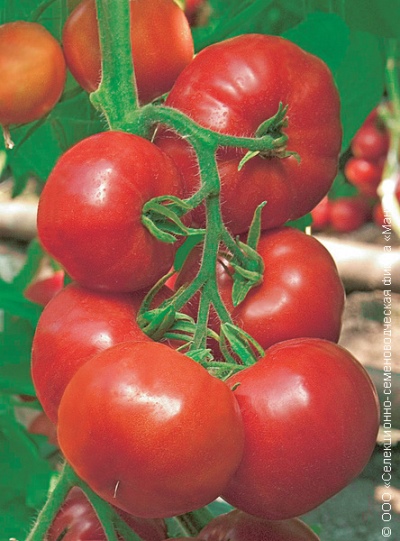
- Authors: Sysina Elena Artemievna, Borisov Alexander Vladimirovich, Krylov Oleg Nikolaevich, Skachko Vladislav Alexandrovich, Bartaya Vera Vladimirovna, LLC "Selection and seed growing company" Manul "
- Year of approval: 2004
- Category: hybrid
- Growth type: indeterminate
- Appointment: universal
- Ripening time, days: 110-115
- Growing conditions: for film greenhouses
- Leaves: medium, green
- Unripe fruit color: green with a dark green spot at the stalk
- Ripe fruit color: Red
Tomato Khan can be a decent choice for even the most picky gardeners who pick and choose crops for their garden. However, in order for their expectations to be met, it is necessary to carefully study all the nuances of handling such a plant. And it's worth starting with finding out where it came from, and what it is botanically.
Breeding history
The culture was developed in the selection and horticultural company "Manul". The "haughty medieval conqueror" was registered in the state register in 2004. Then he was included in the list of varieties recommended for mass cultivation. A whole group of breeders was working on the project:
Sysina;
Borisov;
Krylov;
Skipping;
Bartaya.
Description of the variety
Khan is a standard hybrid with an indeterminate type of development. It is intended for cultivation in film greenhouses. Medium-sized foliage develops on the bushes. A simple green color is typical for her.
The main qualities of the fruit
The berries that have just appeared will be green. Dark green spots will appear near the stem. As the fruit develops further, it will turn red. Ripe berries of medium size, their weight ranges from 80 to 110 g. Tomatoes are laid on complex inflorescences. The first such inflorescence will appear above 10-11 leaves, further - every 3 leaves.
Taste characteristics
The pulp of such a tomato is dense. It differs, judging by the reviews, also in juiciness. The meatiness, again, complements the impression.
Ripening and fruiting
Usually fruit ripeness is reached in 110-115 days. This countdown begins from the appearance of the first green seedlings. However, weather conditions can make significant adjustments to this well-established schedule.
Yield
The variety belongs to the high-yielding group. You can collect from 7.4 to 8.3 kg of berries per 1 m2. The specific result is determined by a number of factors.
The timing of planting seedlings and planting in the ground
Seeds are sown 50-60 days before the approximate time of transplanting to a permanent place. The choice of a specific term is determined by the characteristics of a particular region. The actual weather is also taken into account. Tentatively, the plants will have to be transplanted into the greenhouse in mid-May. Planting in open gardens is mainly carried out in the first decade of June.

Growing tomato seedlings is an extremely important process, because it largely depends on whether the gardener will be able to harvest at all. All aspects must be taken into account, from seedbed preparation to planting in the ground.
Landing scheme
The distance between the tomatoes should be 40-45 cm. For 1 sq. m plant no more than 5-6 plants. This allows, however, an optimal result to be obtained.

Growing and care
The formation of the Khan stem should be done in 1 stem. In any case, it is necessary to form the bushes and form the bushes. Despite its resistance to tobacco mosaic, this plant needs full care. Watering the tomatoes should be regular, but not excessive. And also requires systematic loosening, which allows you to supply the roots of the plant with air.
Some materials indicate that this variety staunchly resists bad weather. It can also be grown outdoors. But in relatively cold regions, it is still better not to risk it and use greenhouses. It is almost impossible to do without feeding.
Seedlings are dived into individual pots in the phase of 2-3 leaves. The size of new pots should be between 5 and 7 cm. Illumination and other parameters of seedling care are not too important. However, overdrying the earth is unacceptable.




A plant needs different micronutrients at each stage of growth. All fertilizers can be divided into two groups: mineral and organic. Folk remedies are often used: iodine, yeast, bird droppings, eggshells.
It is important to observe the rate and period of feeding. This also applies to folk remedies and organic fertilizers.


Growing regions
Khan is advised to cultivate:
in the Volga basin;
in the central Black Earth region;
in the north and northwest of the European part of the Russian Federation;
in the center of the European part;
in the Volgo-Vyatka region;
in the North Caucasus.
Review overview
The plant is quite wonderful. It does not require, according to summer residents, any particularly strenuous care. Even the most common agrotechnical work is quite enough to get a decent harvest. For many people, such a plant falls into the list of their favorite varieties.

























































































